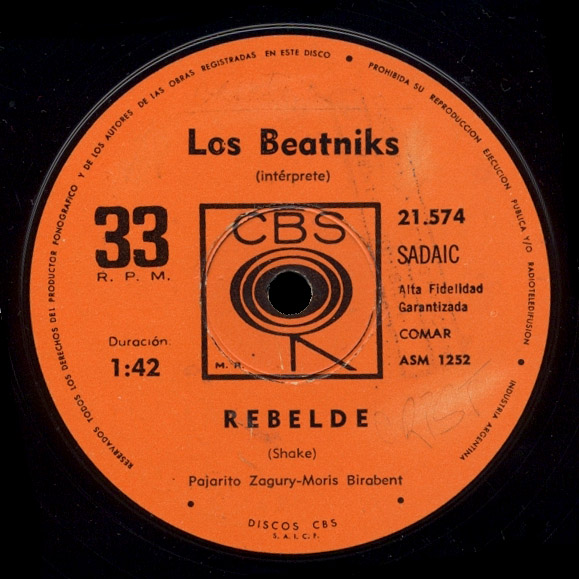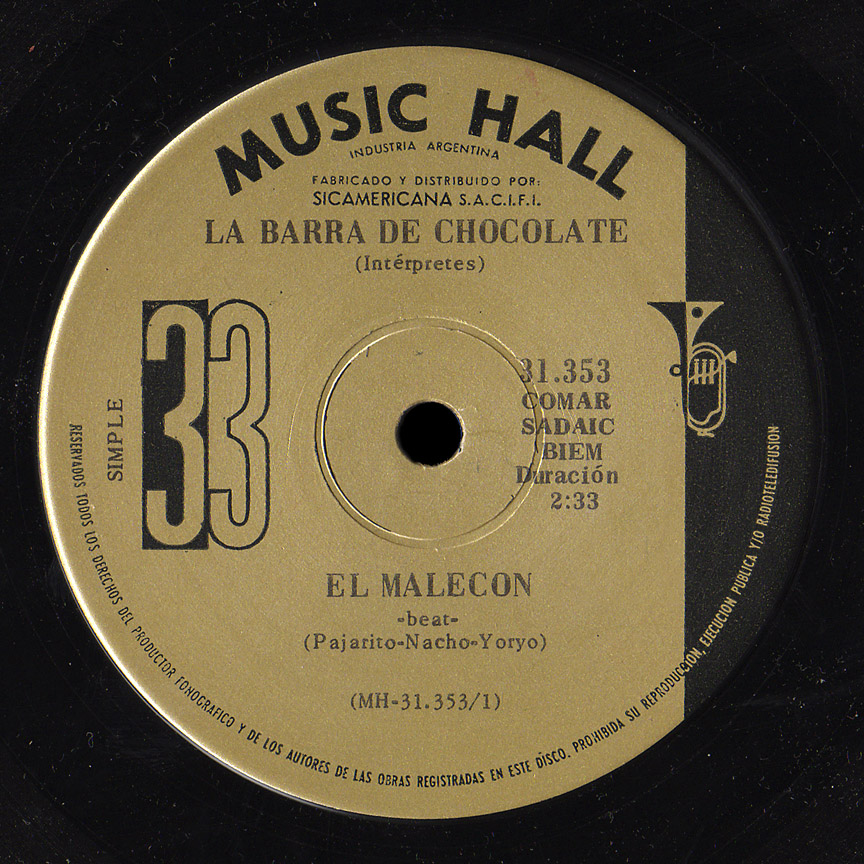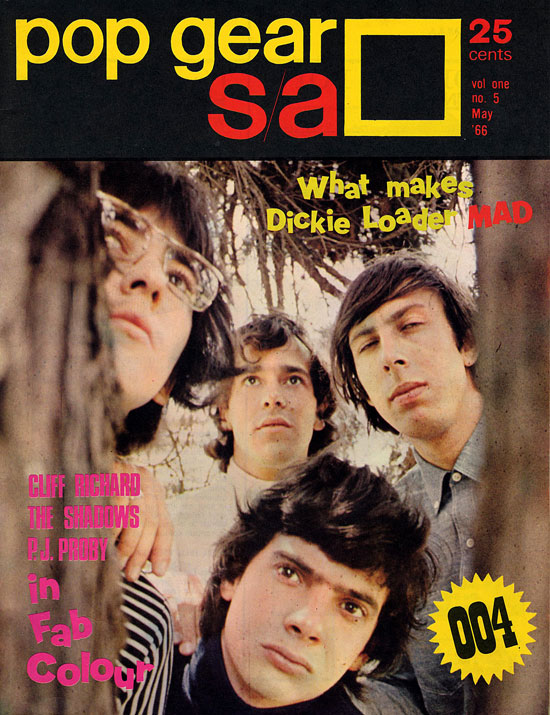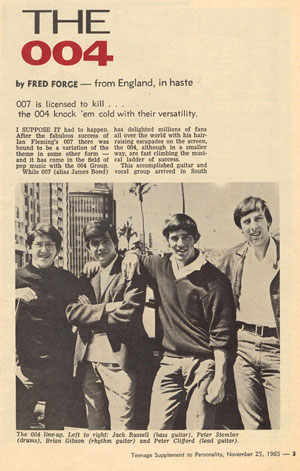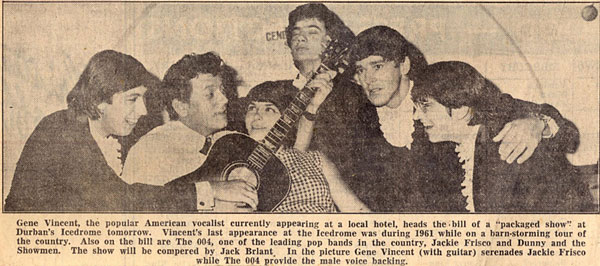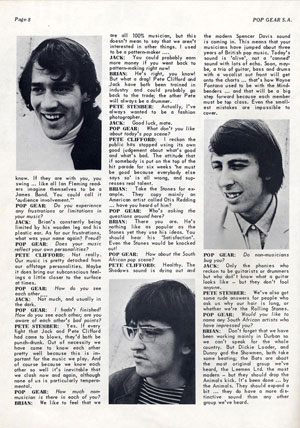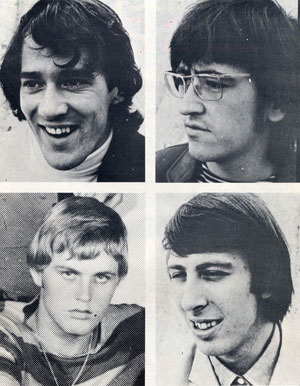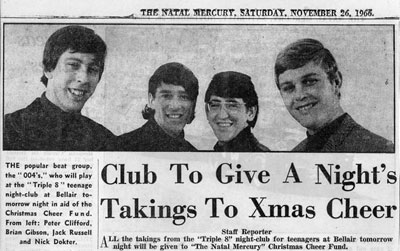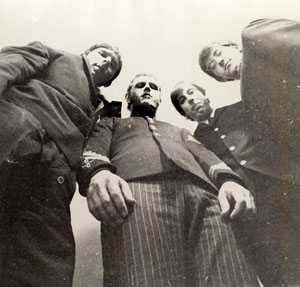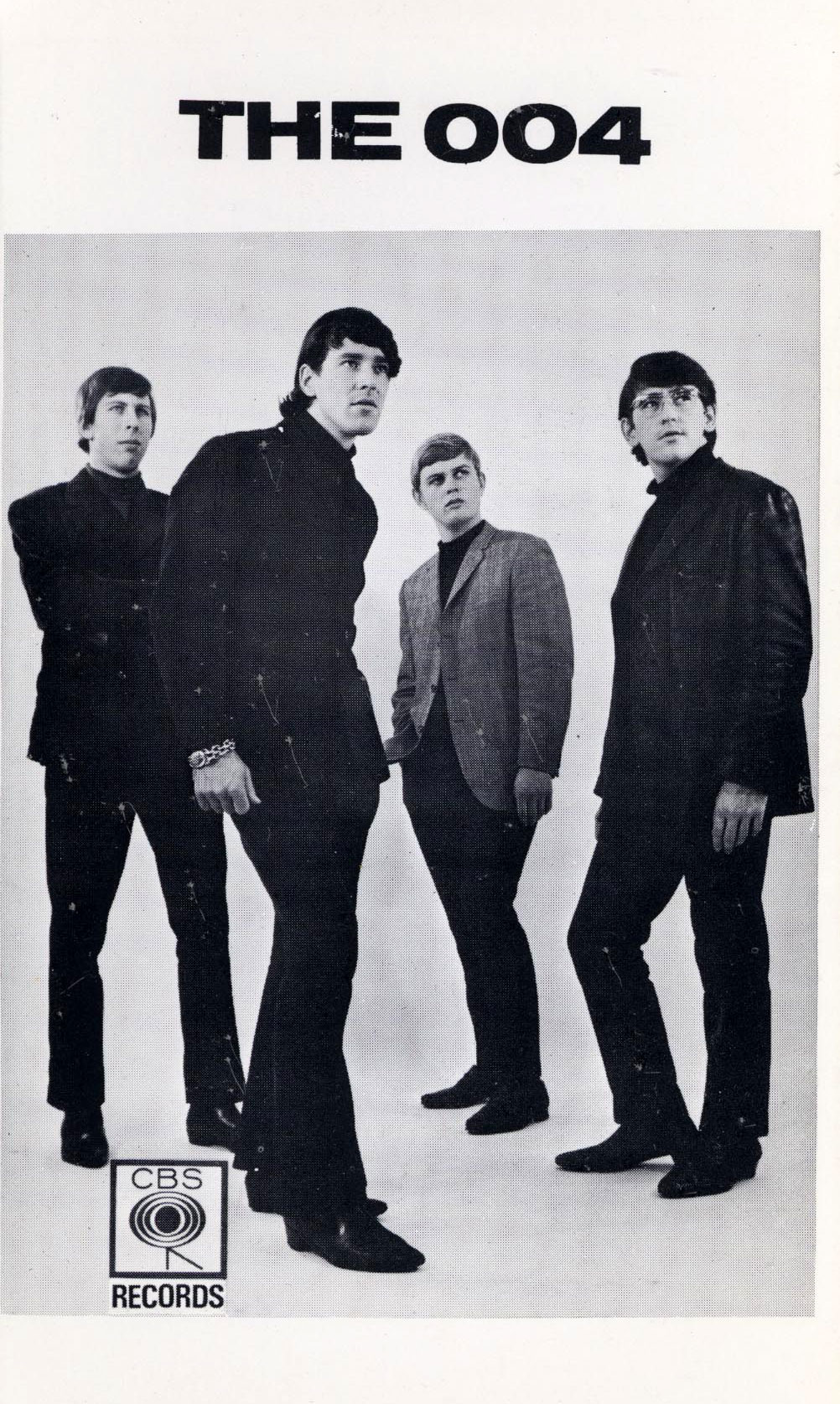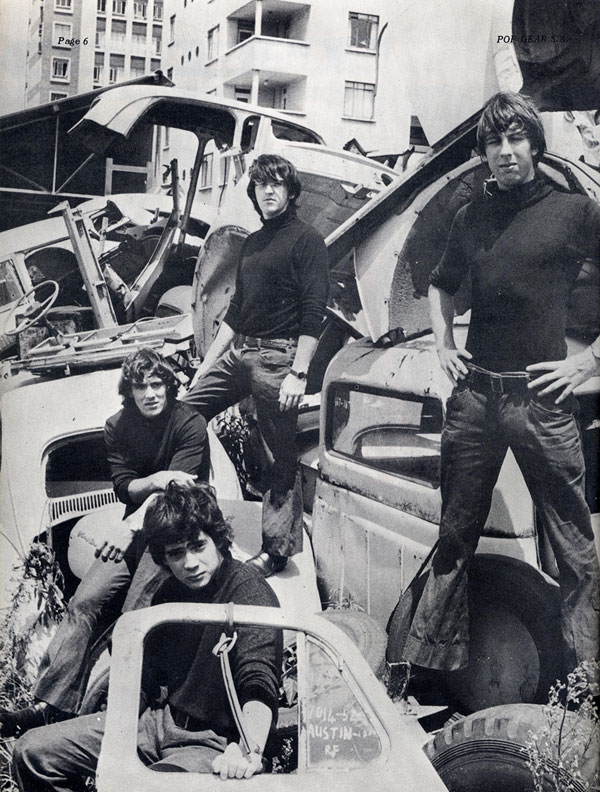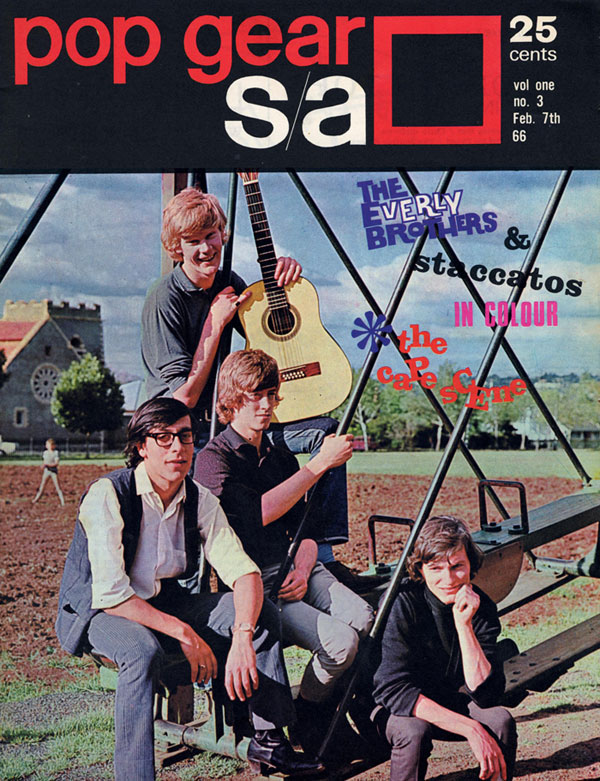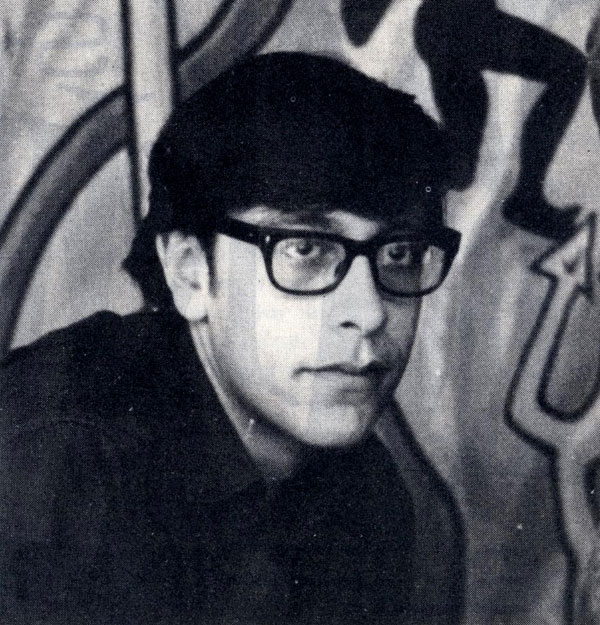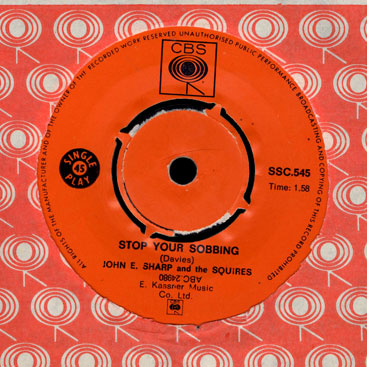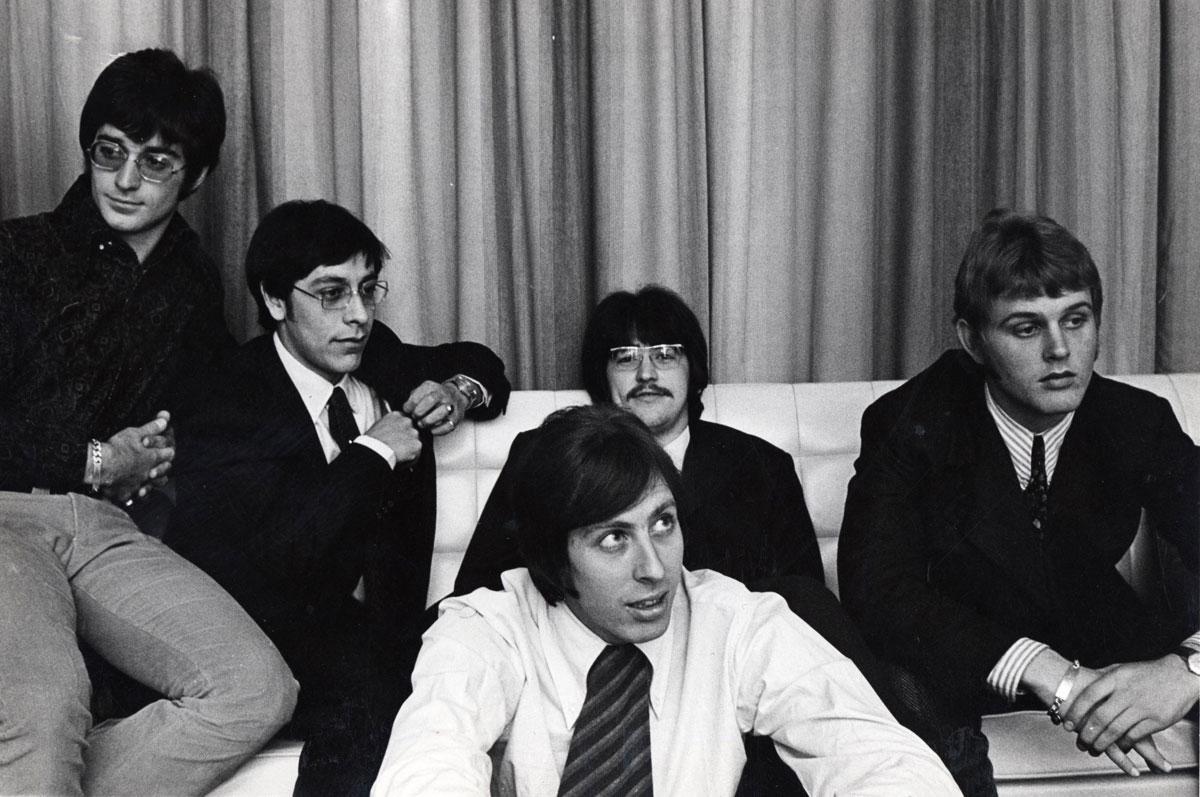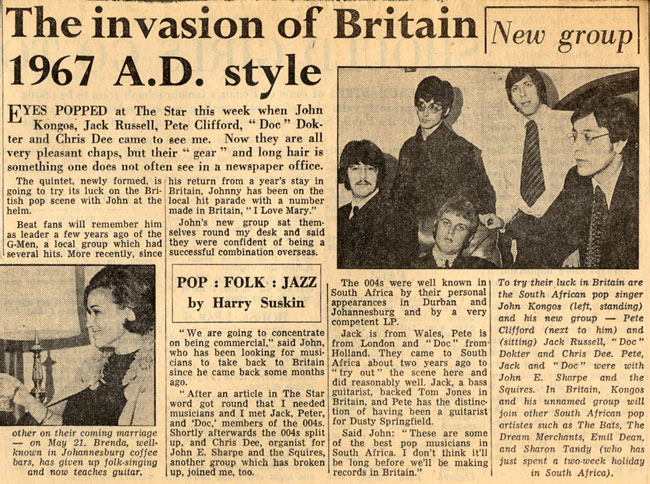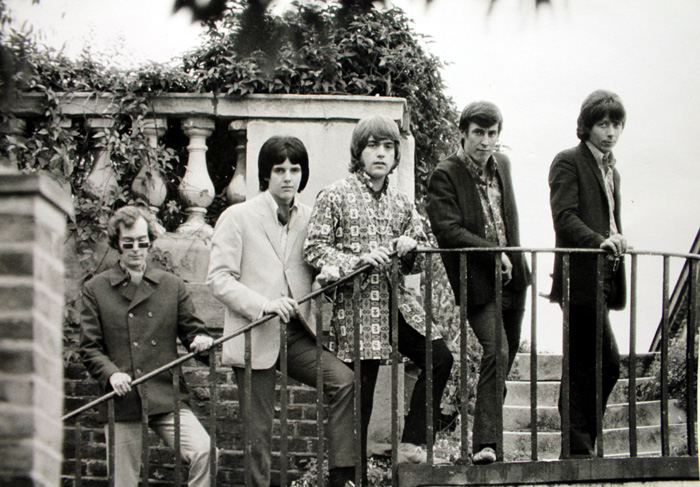
The Kool #1 (August-December 1967)
Jeff Curtis – vocals
Dave Carol – lead guitar, vocals
Jet Hodges (aka Richard Hodgins) – keyboards, vocals
Ray Brown – bass, vocals
Pete Burt – drums
Originally known as Jeff Curtis & The Flames, their manager, rock promoter Mervyn Conn changed their name to The Kool around August 1967.
Signing the band to CBS Records, Conn used The Ivy League and session musicians, including drummer Clem Cattini, to record Tony Macauley and John MacLeod’s poppy “Look at Me, Look at Me”, which was backed by the soulful “Room at the Top” (credited to Curtis’s real name: David Myers but actually a co-write with Ray Brown and originally cut as a demo by Jeff Curtis & The Flames around May 1966).
The A-side only features Ray Brown from the band who provides the lead vocal and is surrounded by the massed vocals of The Ivy League. The B-side is notable for its use of horns and cello and has a soulful feel with Jeff Curtis’s gravelly voice to the fore.
Produced by Mervyn Conn and arranged by Keith Mansfield, the single was released on 12 October 1967 but did not chart despite being plugged by DJ Tony Blackburn on Radio 1.
During the same session, Conn used The Ivy League as singers on an excellent version of “Step Out of Your Mind”, previously recorded and released in the United States by The American Breed, and a cover of Ralph Murphy’s “Funny What a Fool Can Be”. Like the previous B-side, Jeff Curtis sang lead vocals on this track and the band members are featured on the recording.
The two tracks were coupled for a second single, issued, and then mysteriously withdrawn, in limited edition, around December 1967.
That same month, the band played at Coronation Hall in Kingston with PP Arnold, after which Ray Brown departed to reunite with Steve Reading and Mickey Baker from his 1950s band, The Sky Blue Skiffle Group, in a new outfit called Champagne. During 1968, Champagne shared the bill with The Kool at Kew Boathouse. In 1969, Brown joined The Magic Roundabout.
With Ray Brown out of the picture, The Kool carried on, bringing in new bass player Brian Hosking.
Notable gigs:
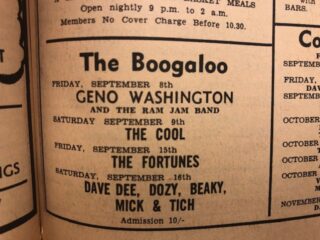
9 September 1967 – Boogaloo, Castleford, West Yorkshire Billed as The Cool so may be another band

15 September 1967 – Cesar’s Club, Bedford with The 100w Carnation
1 December 1967 – Coronation Hall, Kingston Upon Thames, Surrey with PP Arnold (may have been later this month or first week in January)
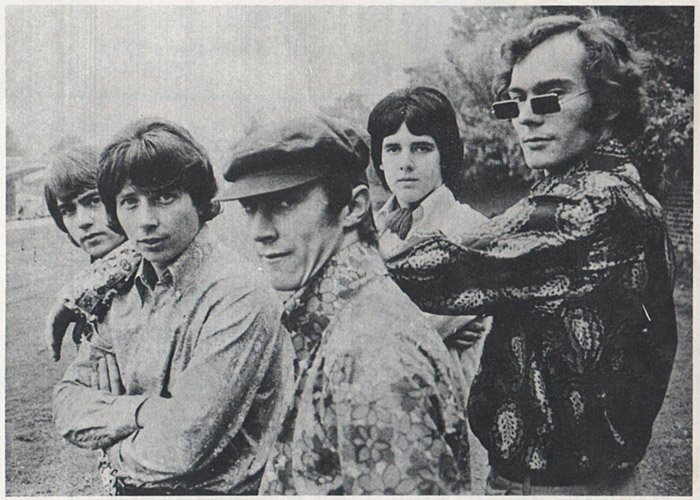
The Kool #2 (January-August 1968)
Jeff Curtis – vocals
Dave Carol – lead guitar, vocals
Jet Hodges (aka Richard Hodgins) – keyboards, vocals
Brian Hosking – bass
Pete Burt – drums
Originally from Twickenham, Middlesex, Brian Hosking (b. 7 July 1947, Twickenham, Middlesex) was no stranger to the band having known Dave Carol from The Smokestacks in 1964. Hosking had first played bass with The Diplomats while at school and then joined The Feeet with guitarist Doug Ayris. During 1963, Hosking and Ayris formed The Legend with singer Nigel Kingswell and drummer John Sergeant.
In 1964, Hosking left to join The Smokestacks. Two years later, he helped form Twickenham band, The All Night Workers. However, after a few months, he departed to run a bar full-time in Heston and only returned to the live scene in October 1967 with a short-lived band called Deep Purple (no relation to their more famous namesake). When he joined The Kool, Hosking had given up the bar to sell car batteries in Slough and was living in Hounslow.
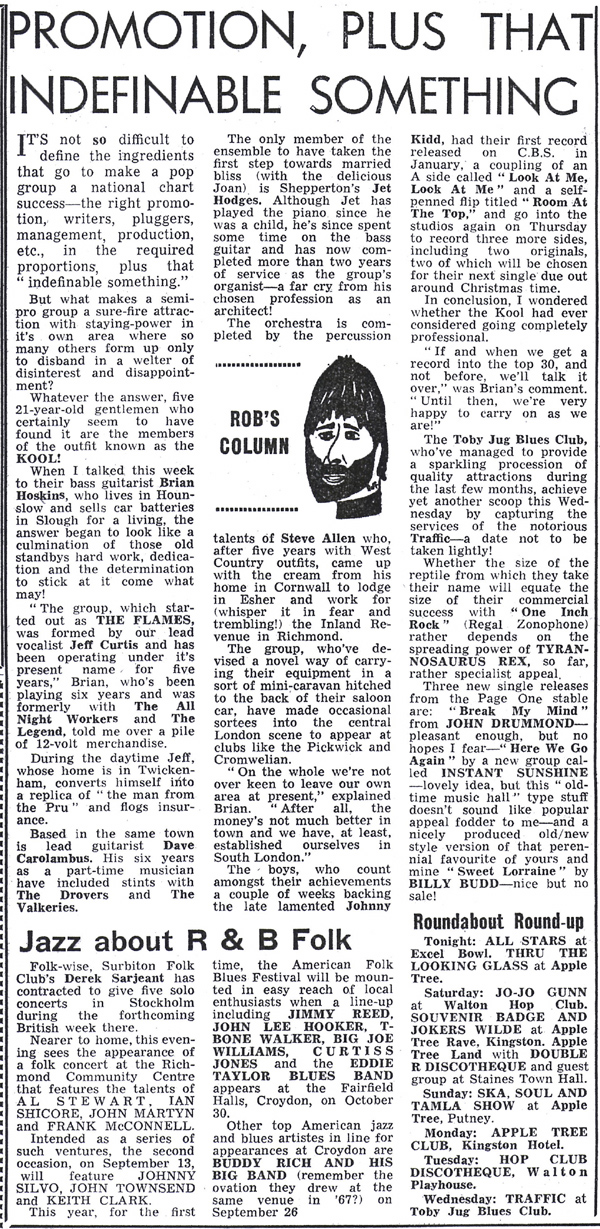
In early 1968, The Kool appeared at London’s top nightclubs, the Cromwellian and the Pickwick. During the second part 1968, the band increasingly found work in the Kingston-Upon-Thames, Surrey area.
Notable gigs:
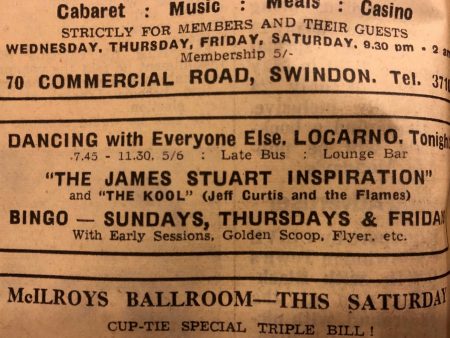
27 January 1968 – Locarno Ballroom, Swindon, Wiltshire with James Stuart Inspiration
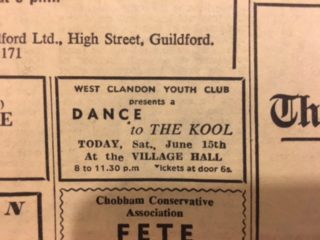
15 June 1968 – West Clandon Youth Club, West Clandon, Surrey
22 June 1968 – Excel Bowl, Tolworth, Surrey
6 July 1968 – Excel Bowl, Tolworth, Surrey
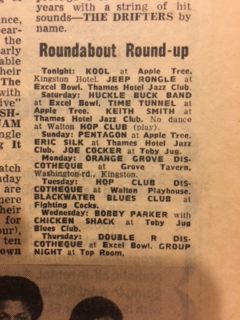
19 July 1968 – Apple Tree Club, Kingston Hotel, Kingston upon Thames, Surrey
The Kool #3 (August 1968-January 1969)
Jeff Curtis – vocals
Dave Carol – lead guitar, vocals
Jet Hodges (aka Richard Hodgins) – keyboards, vocals
Brian Hosking – bass
Steve Allen – drums
During late summer Pete Burt departed and joined up with keyboard player Bob Brittain for a tour of Germany. In 1969, Brittain offered Burt the drum position in his new band, Pickettywitch but the drummer declined the offer. The following year, he reunited with his old school friend from Roxeth Manor School – Rod Wharton and they formed the trio, Hogsnort Rupert. Burt subsequently retired from the music business and passed away on 20 March 2013.
Steve Allen, who was originally from Cornwall and had played in several West Country bands for five years before moving to Esher, Surrey, took over from Burt while working for the Inland Revenue in Richmond, Surrey during the day.
According to the Kingston and Malden Borough News, the new line up returned to the studios in early September 1968 to record three more sides, including two band originals, and two of the tracks recorded would be chosen for the band’s next single, due out around Christmas. The promised single never appeared.
The new Kool line-up, however, was short-lived because Allen did not like the band’s music and departed early on to join The Factory, led by singer Jack Brand.
Notable gigs:
16 August 1968 – Apple Tree Club, Kingston Hotel, Kingston upon Thames, Surrey
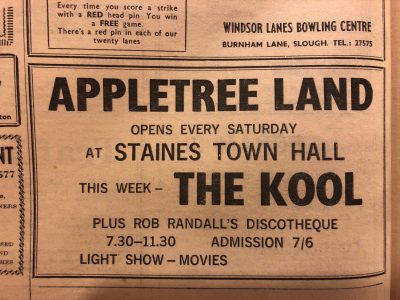
24 August 1968 –Staines Town Hall, Staines, Middlesex
25 August 1968 – Apple Tree Club, White Lion, Putney, Southwest London
18 November 1968 – Orange Grove, Grove Tavern, Kingston upon Thames, Surrey
6 December 1968 – Apple Tree Club, Kingston Hotel, Kingston upon Thames, Surrey
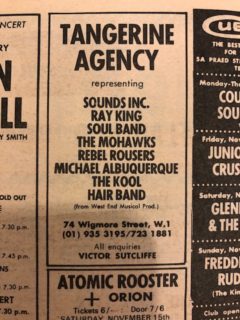
The Kool #4 (January-May 1969)
Jeff Curtis – vocals
Dave Carol – lead guitar, vocals
Jet Hodges (aka Richard Hodgins) – keyboards, vocals
Brian Hosking – bass
Geoff Coxon – drums
Dave Carol enlisted his old friend from early 1960s band, The Drovers, Geoff Coxon, to replace the outgoing Steve Allen. Since splitting from Carol in 1964, Coxon had joined Hampton, Middlesex band, The Others, just in time to promote their lone single on Fontana, a raucous version of Bo Diddley’s “Oh Yeah”, coupled with the band original “I’m Taking Her Home”.
After The Others fell apart in October of that year, Coxon moved on to work with Colin Shane & The Shannons alongside guitarist Dave Mumford and bass player Dick Merritt. When this group split up in late 1965, the trio formed The Sugar Band with organist Malcolm Wainman, tenor sax player Pete Browning and baritone sax player Les Batt and worked the soul club circuit until late 1967.
The band’s agent then linked the musicians with Jamaican singer Delroy Williams and they became The Delroy Williams Show with The Sugar Band. By late 1968, the group had split from Williams and Coxon gigged around before joining The Kool.
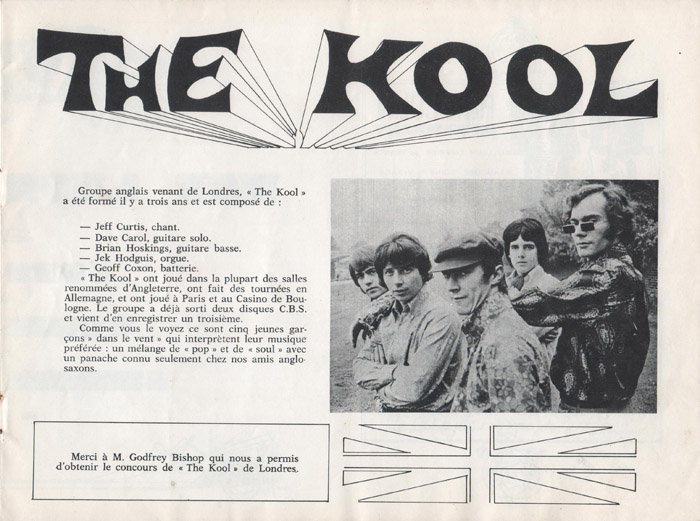
The new line up travelled to France to play the Grand Ball at Caen University in early February. During that weekend, the new band members did a signing at a record shop for their forthcoming CBS single, which featured a photo of the original line up.
On 18 April 1969, CBS belatedly released The Kool’s second single, “Step Out of Your Mind” c/w “Funny What A Fool Can Be”, over a year after it was originally recorded. Despite a strong performance, the band’s moment had passed and the single failed to chart.
The single was reviewed in the Kingston and Malden Borough News’s 25 April 1969 edition, together with a photo of the original line up.
The current line up, however, signed to MCA and recorded a final single, issued in June 1969, coupling the poppy “Lovin’”, written by the song-writing team Capitanelli and O’Connor, backed by Dave Myers’ original, “Baby’s Out of Reach”. Produced by Phil Swern, arranged by Tom Parker, and with backing vocals by Sue and Sonny, the single had great potential but was another chart failure.
Before it was released both Jet Hodges and newcomer Geoff Coxon departed. Coxon joined Calum Bryce, reuniting with Dave Mumford. Coxon currently performs with a reformed The Others.
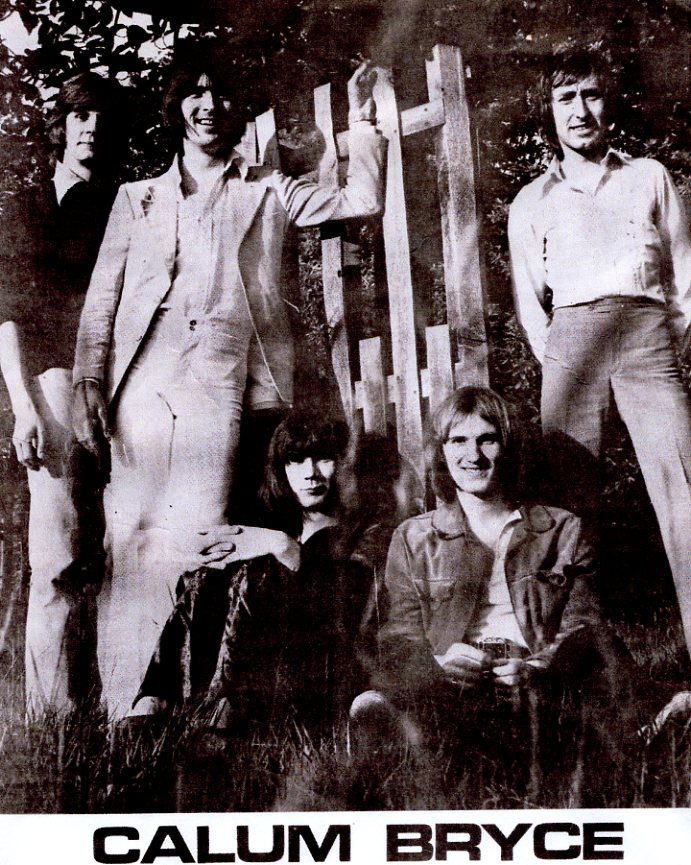
Notable gigs:
15 January 1969 – Weybridge Hall, Weybridge, Surrey
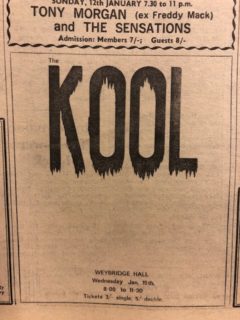
8 February 1969 – Grand Ball, Caen University, France

2 May 1969 – Addlestone Community Centre, Addlestone, Surrey
The Kool #5 (May-August 1969)
Jeff Curtis – vocals
Dave Carol – lead guitar, vocals
Ronnie Clayden – keyboards, vocals
Brian Hosking – bass
Jim Park – drums
Jim Park (b. 21 March 1947, Staines, Middlesex) was recruited via an advert that Hosking put in Melody Maker. The band received over 60 applications for the drum vacancy but Park knew Clive Burrows, who was singing in the latest version of Hosking’s former group The All Night Workers, which still contained Hosking’s former band mate from The Legend, Doug Ayris. Burrows also worked as a store man at a shop Hosking’s girlfriend managed.
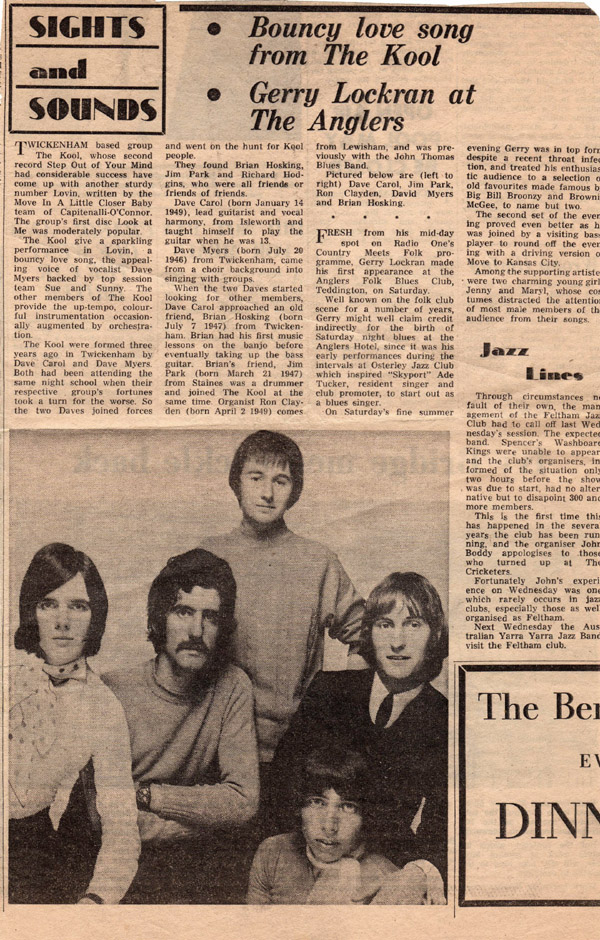
Barely 20 years old, Clayden (b. 2 April 1949, Lewisham, Kent) was living in Ascot, Berkshire at the time and had previously worked with Maidenhead band, The John Thomas Blues Band, which included lead guitarist Graham Marshall and drummer Chris Stevens.
The John Thomas Blues Band landed loads of support gigs opening for the likes of The Pretty Things, The Gun and Aynsley Dunbar’s Retaliation and had even spent a brief period backing American blues singer/pianist Champion Jack Dupree. The John Thomas Blues Band appeared at the Crown pub in Twickenham on 11 January 1969. Clayden finds out about the position in The Kool through Jim Park whose parents worked with his.
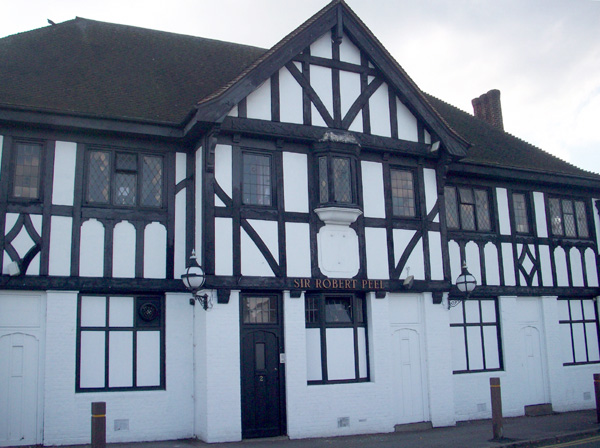
The Kool, however, were nearing their end and during a run of shows at the Sir Robert Peel in Kingston Upon Thames, Surrey, longstanding front man Jeff Curtis quit the band and was replaced by singer Roger Semon, who’d previously fronted The In-Sekt Ltd and Coconut Ice.
Not long after newcomer Jim Park also departed and subsequently re-joined The All Night Workers. Alan Cottrell took his place on the drum stool.
After leaving the band he had led for nearly a decade, Jeff Curtis reverted to his real name, David Myers, and set up his own restaurant business. He died in tragic circumstances in the late 1990s.
Notable gigs:
19-20 July 1969 – Sir Robert Peel, Kingston upon Thames, Surrey
7 August 1969 – Sir Robert Peel, Kingston upon Thames, Surrey
9 August 1969 – Hog’s Back Hotel, Seale, near Farnham, Surrey
12 August 1969 – Sir Robert Peel, Kingston upon Thames, Surrey
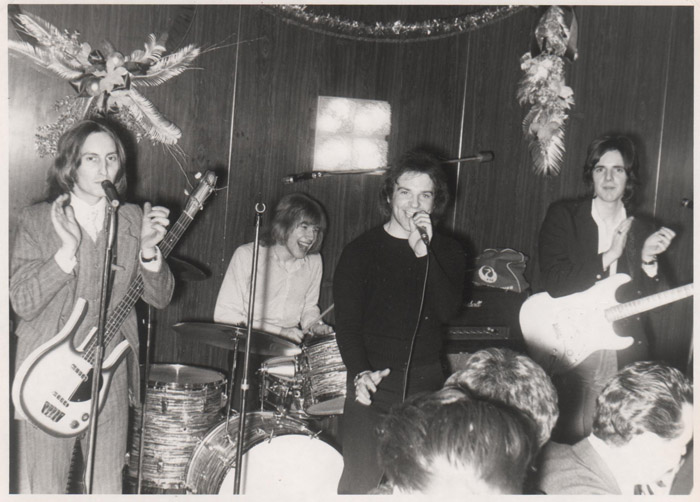
The Kool #6 (September 1969-December 1970)
Roger Semon – vocals
Dave Carol – lead guitar, vocals
Ronnie Clayden – keyboards, vocals
Brian Hosking – bass
Alan Cottrell – drums
Despite losing their longstanding frontman, The Kool continued into 1970 but did not record any more material. In early 1971, Hosking and Clayden both left.
Hosking later moved to the Guildford area where he worked with the band Bloodhound. Based on Bournemouth, he is currently working with a reformed version of The All Night Workers. Clayden, meanwhile, subsequently moved to the Camberley/Ascot area on the Surrey/Berkshire border and worked with the band, Snow Leopard. He later moved to the United States where he currently resides.
After bringing back Hosking’s predecessor Ray Brown from Magic Roundabout and carrying on without a keyboard player, the final line up continued as Easy Virtue throughout 1971. During that year, John Frost took over the drum stool from Alan Cottrell.
In 1972, Carol left and was replaced by lead guitarist Frank Torpey, who’d been in the original Sweet. The band then changed name to Crackers. However, in 1973, John Frost left to re-join Carol in a new version of Easy Virtue, which lasted into the mid-1970s. Carol subsequently left the music business and currently runs his own restaurant business in Southwest London.
Ray Brown meanwhile stayed in the music business until the mid-1980s. Crackers were studio winners on Opportunity Knocks in 1976 and recorded material at Abbey Road and Surrey Sound Studios. Three tracks featuring Roger Semon, Ray Brown and Frank Torpey were released under the name Horrorcomic on Lighting Records in 1977 and reached #28 in Melody Maker’s punk charts.
Two further singles were released in 1978 and 1979 with Roger Willis from Capability Brown on drums. All of the single releases, plus six previously unreleased recordings were issued in 2006 by Sanctuary Records on the CD England 77’. Brown later worked with comedy show group The Wallies and The Beasty Grandads before retiring from the music business in September 1988. He currently lives in Surrey.
Notable gigs:
10 September 1969 – Sir Robert Peel, Kingston upon Thames, Surrey
17 September 1969 – Sir Robert Peel, Kingston upon Thames, Surrey
27 September 1969 – Kingston College of Technology, Kingston upon Thames, Surrey with Bobby Kerr Whoopee Band and The Webb

5 December 1969 – Excel Bowl, Tolworth, Surrey
22 December 1969 – Chessington Youth Club, Chessington, Surrey
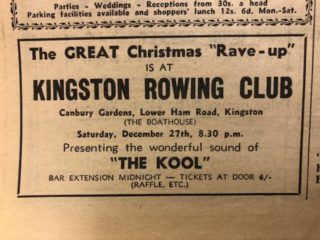
27 December 1969 – Kingston Rowing Club, Kingston upon Thames, Surrey
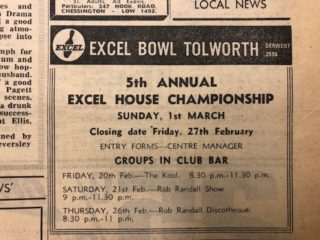
20 February 1970 – Excel Bowl, Tolworth, Surrey
7 March 1970 – Kingston Rowing Club, Kingston upon Thames, Surrey
21 March 1970 – Hook Youth Club, Hook, Surrey
4 April 1970 – Claygate Village Hall, Claygate, Surrey
17 April 1970 – Excel Bowl, Tolworth, Surrey
24 April 1970 – Hook Youth Club, Hook, Surrey
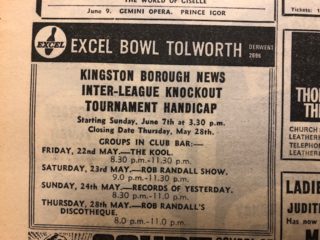
22 May 1970 – Excel Bowl, Tolworth, Surrey
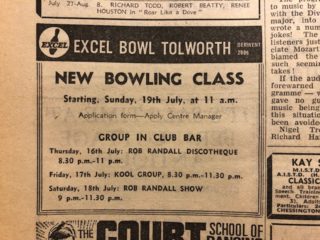
17 July 1970 – Excel Bowl, Tolworth, Surrey
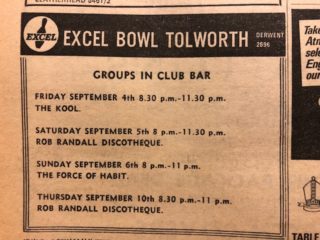
4 September 1970 – Excel Bowl, Tolworth, Surrey

23 October 1970 – Excel Bowl, Tolworth, Surrey
A huge thanks goes to Dave Carol, Pete Burt, Brian Hosking, Geoff Coxon, Ronnie Clayden, Ray Brown, Rod Wharton and John Frost. The Kingston and Malden Borough News also proved useful. Many thanks to Brian Hosking, Ray Brown and Ronnie Clayden for providing some of the images. This is dedicated to Pete Burt.
45 releases:
Look at Me, Look at Me/Room at the Top (CBS 203003) 1967
Step Out of Your Mind/Funny (What a Fool a Can Be) (CBS 2865) April 18, 1969
Lovin’/Baby’s Out of Reach (MCA MU 1085) 1969
Copyright © Nick Warburton. All Rights Reserved. No part of this article may be reproduced or transmitted in any from or by any means, without prior permission from the author.
I have tried to ensure the accuracy of this article but I appreciate that there are likely to be errors and omissions. I would appreciate any feedback from anyone who can provide any additions or corrections. Email: Warchive@aol.com

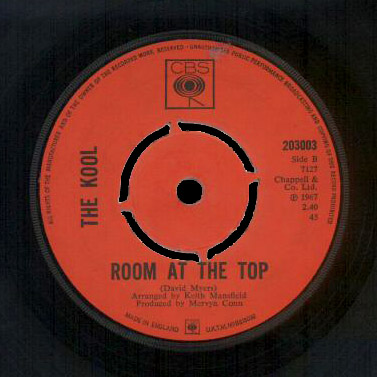
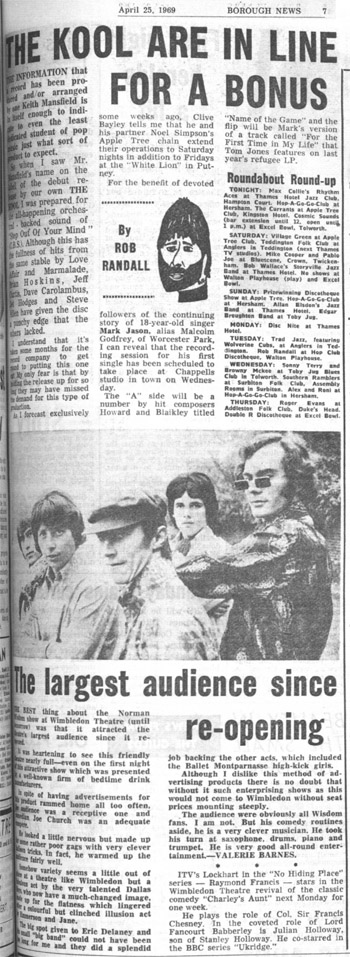
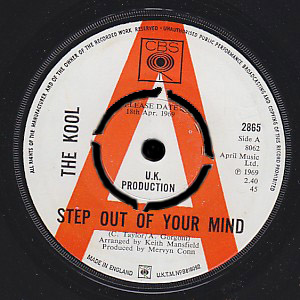
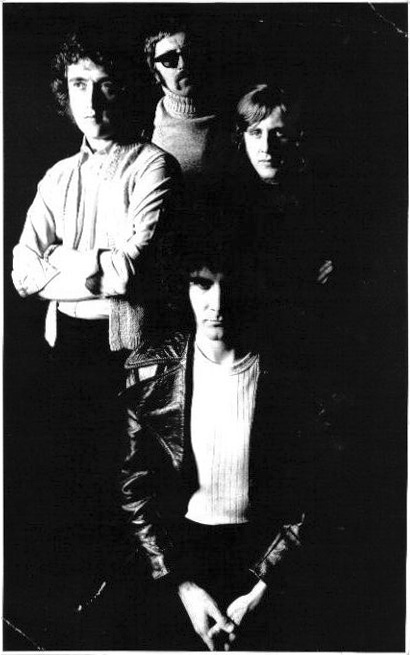
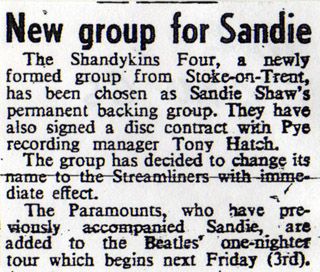
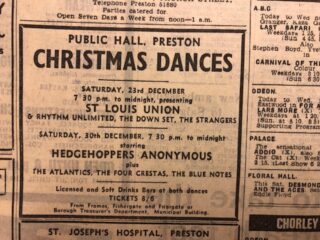
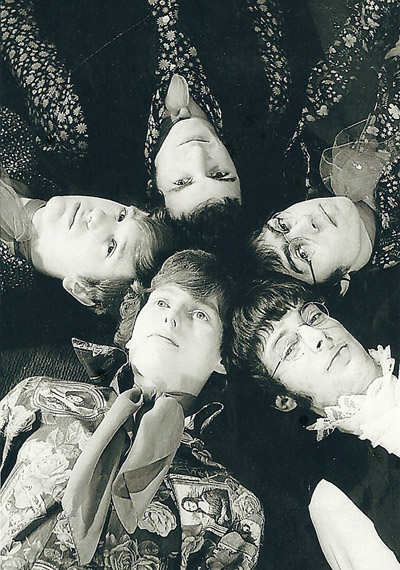

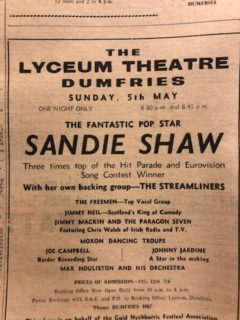
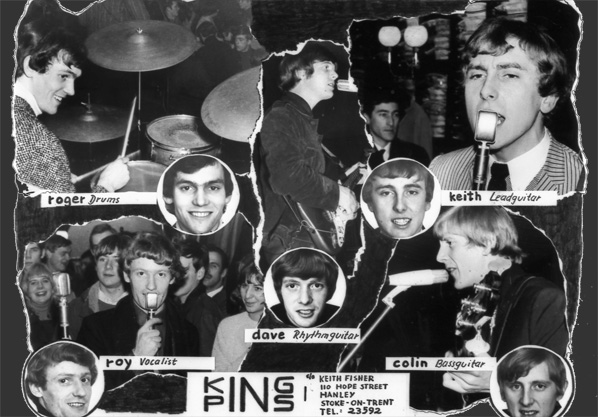
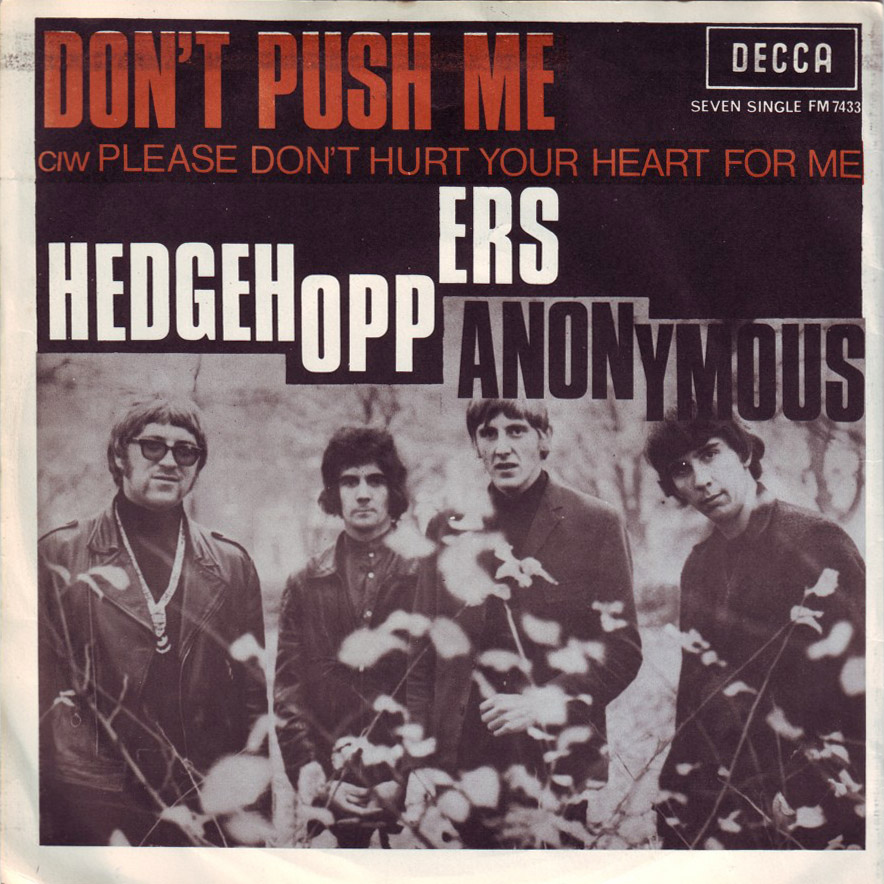
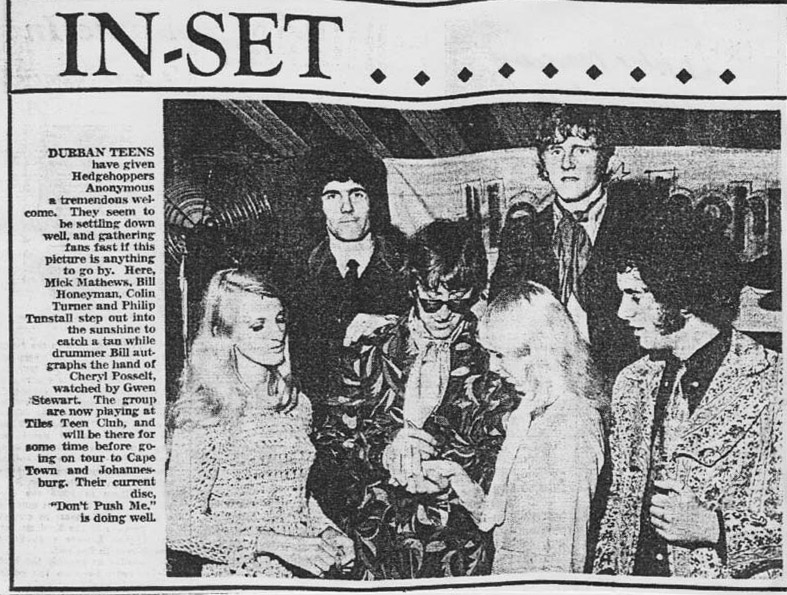
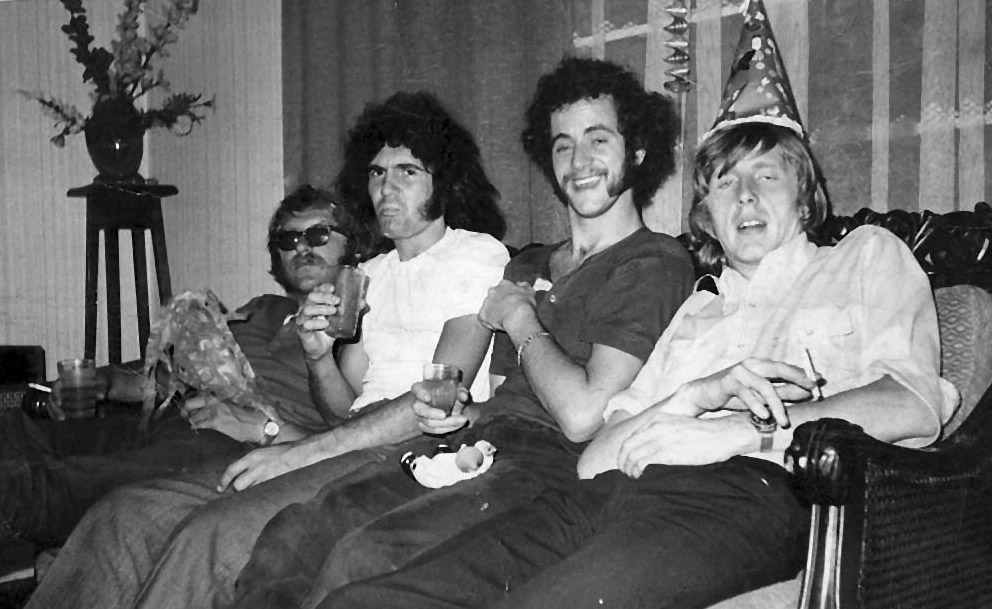
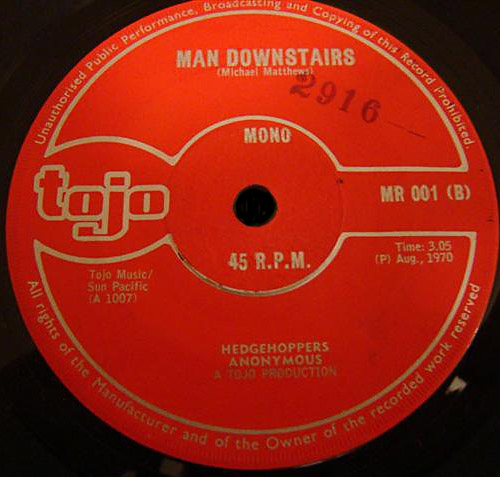
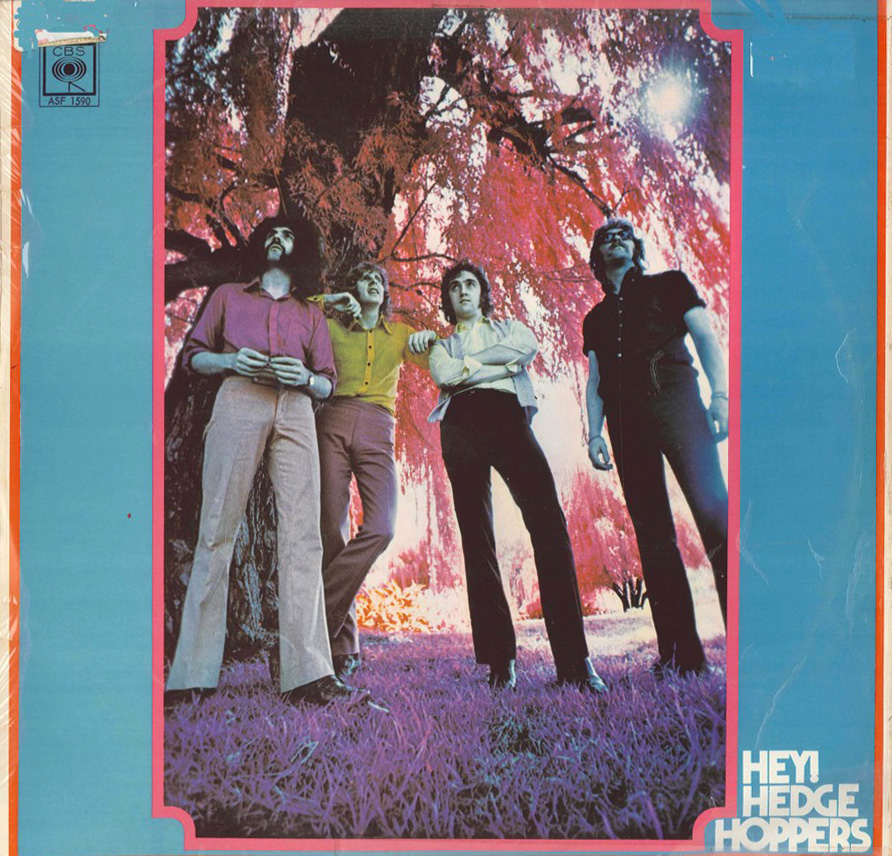
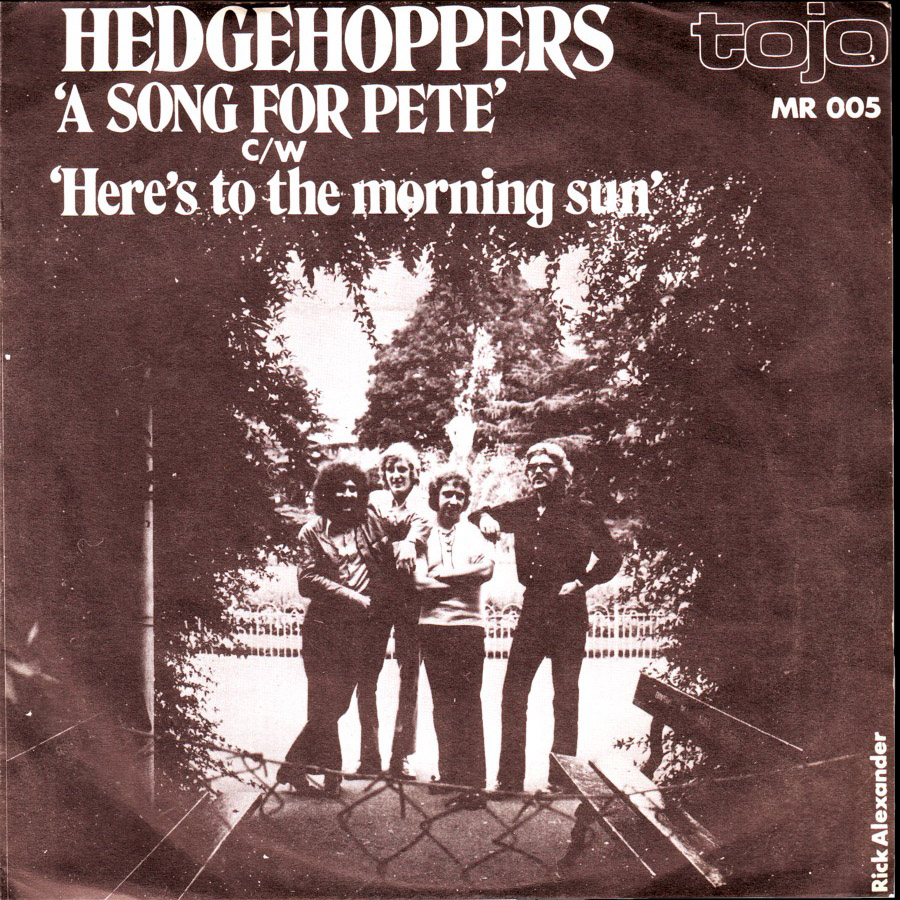
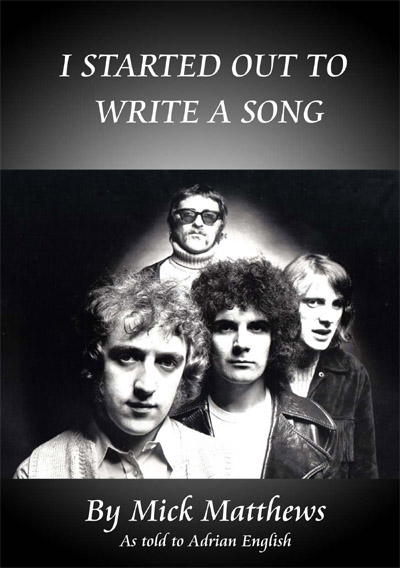
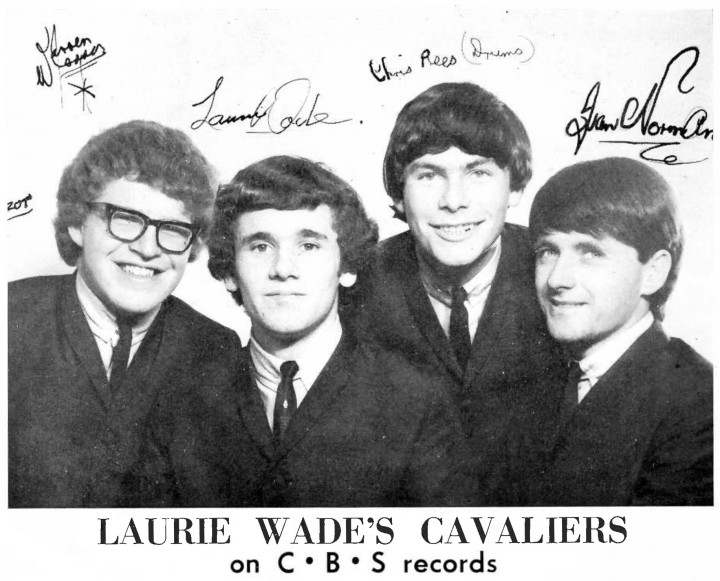
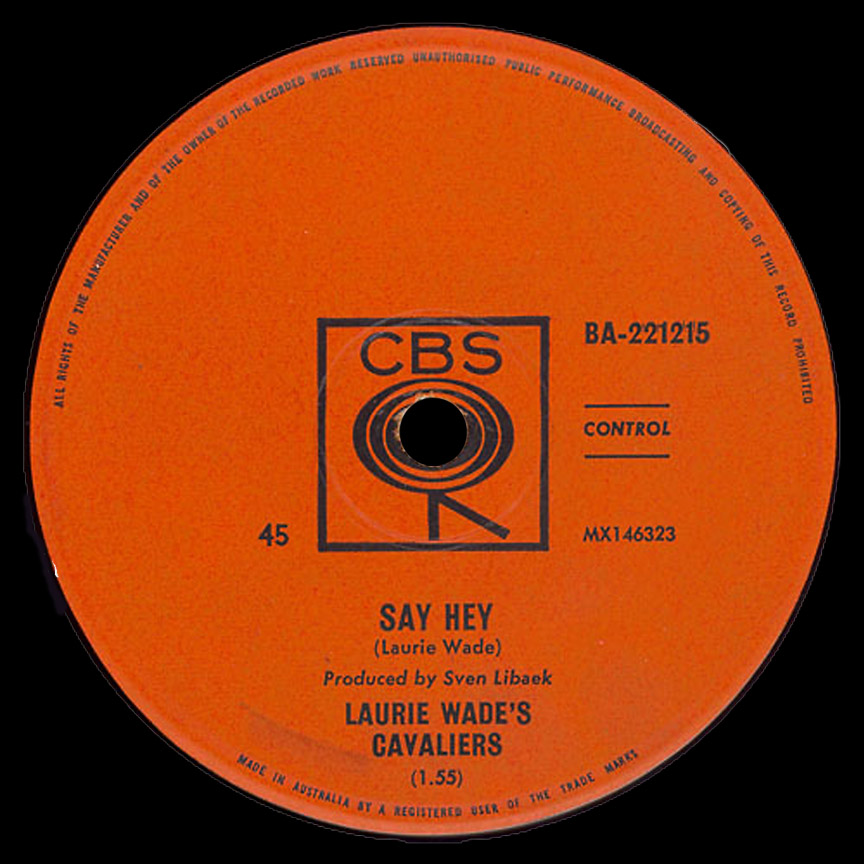 Laurie Wade’s Cavaliers started as a surf group, cutting one instrumental single for the Linda Lee label, “Cloudburst” / “The Phantom Guitarist” (written by Laurie Mudge). Hear this first singel on Big Beat’s excellent compilation: Board Boogie: Surf ‘n’ Twang from Down Under).
Laurie Wade’s Cavaliers started as a surf group, cutting one instrumental single for the Linda Lee label, “Cloudburst” / “The Phantom Guitarist” (written by Laurie Mudge). Hear this first singel on Big Beat’s excellent compilation: Board Boogie: Surf ‘n’ Twang from Down Under).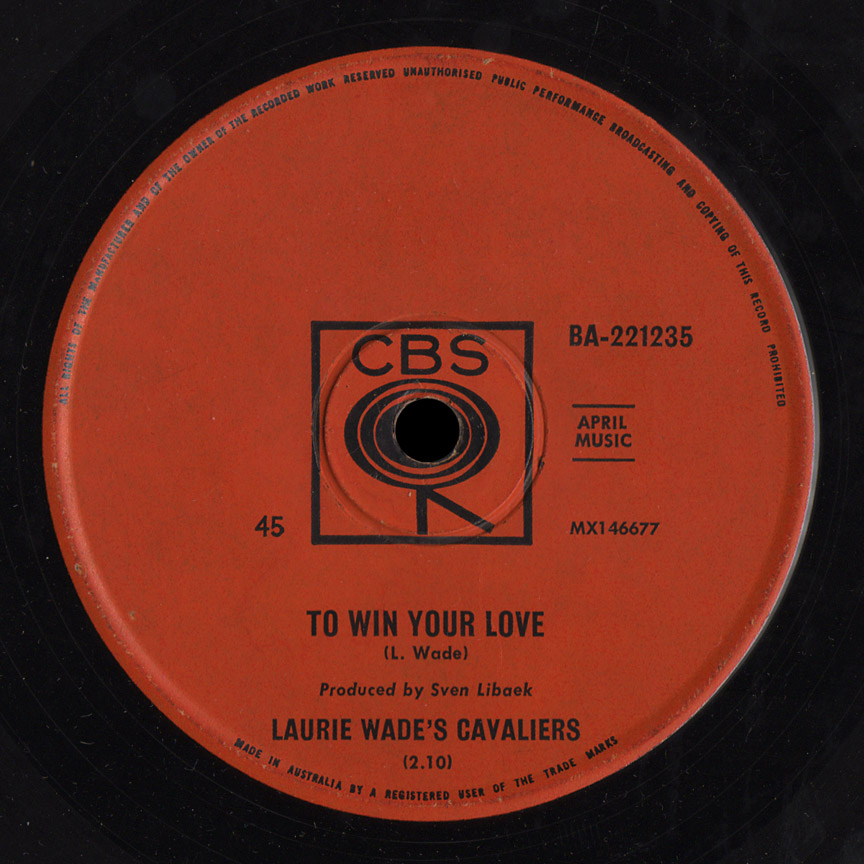 The second was an excellent Laurie Wade original, “To Win Your Love”. It’s probably my favorite of their recordings that I’ve heard, with two good guitar breaks, rollicking piano and solid rhythm backing over Laurie’s great vocal. The flip is another Wade original, “Don’t Quit Now”. It’s not a bad song, though I’m mystified by the engineering, as the rhythm guitar starts off too loudly, only to be dimmed along with the rest of the band just six seconds into the song.
The second was an excellent Laurie Wade original, “To Win Your Love”. It’s probably my favorite of their recordings that I’ve heard, with two good guitar breaks, rollicking piano and solid rhythm backing over Laurie’s great vocal. The flip is another Wade original, “Don’t Quit Now”. It’s not a bad song, though I’m mystified by the engineering, as the rhythm guitar starts off too loudly, only to be dimmed along with the rest of the band just six seconds into the song.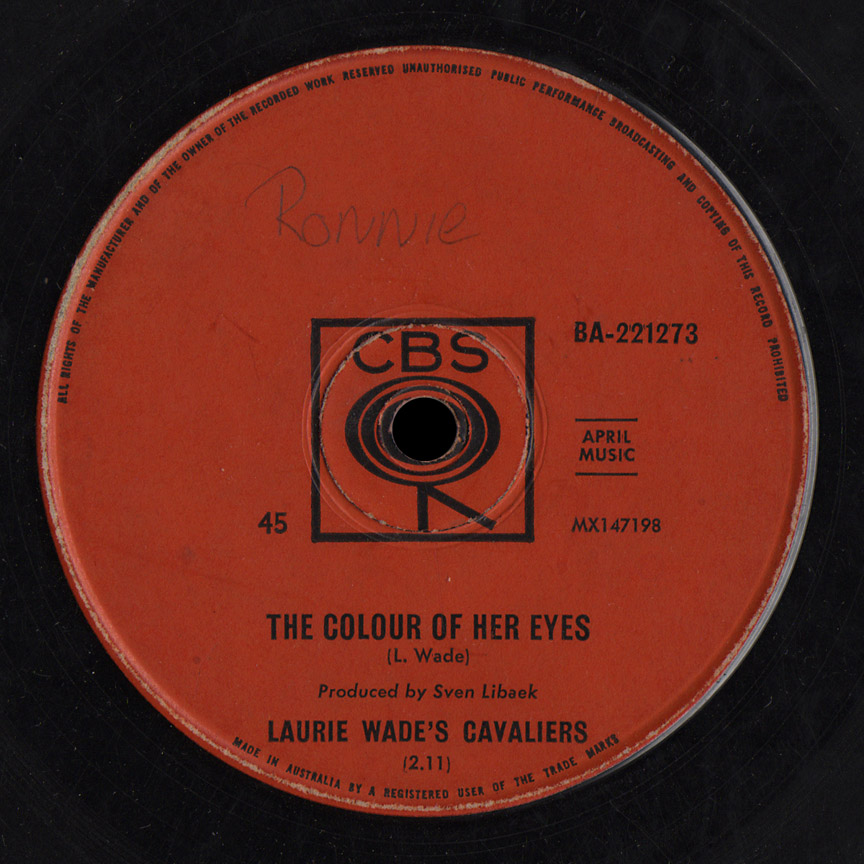 In 1966 they cut their most adventurous song, Wade’s “The Colour of Her Eyes”, beginning with a riff like something out of a Sonics song. The rhythm guitarist takes a page out of the surf guitar book, strumming over deadened strings with heavy reverb for a cool background sound. Laurie’s vocals alternate between gloomy and wailing!
In 1966 they cut their most adventurous song, Wade’s “The Colour of Her Eyes”, beginning with a riff like something out of a Sonics song. The rhythm guitarist takes a page out of the surf guitar book, strumming over deadened strings with heavy reverb for a cool background sound. Laurie’s vocals alternate between gloomy and wailing!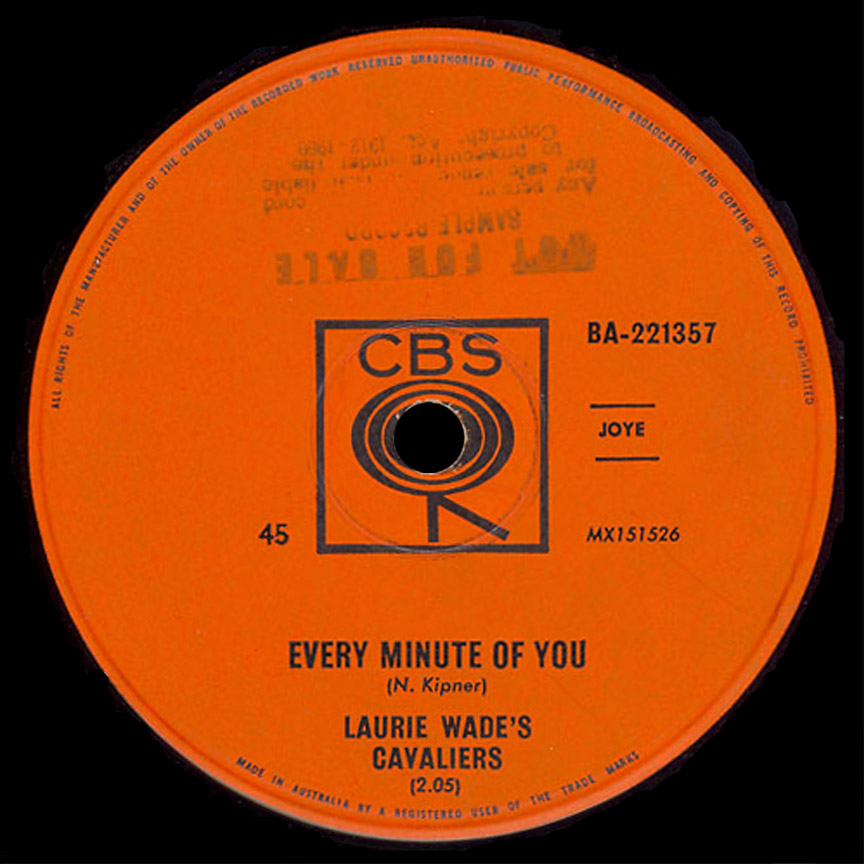 I knew Marty Rhone’s raving version of “Every Minute of You”, but I hadn’t heard Laurie Wade’s original recording of it when I first wrote this article. It surprised to hear the band going in a more soulful direction, though it suits Laurie’s voice. Marty Rhone’s release came shortly after.
I knew Marty Rhone’s raving version of “Every Minute of You”, but I hadn’t heard Laurie Wade’s original recording of it when I first wrote this article. It surprised to hear the band going in a more soulful direction, though it suits Laurie’s voice. Marty Rhone’s release came shortly after.